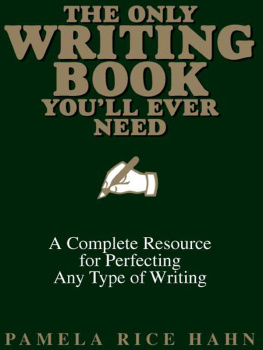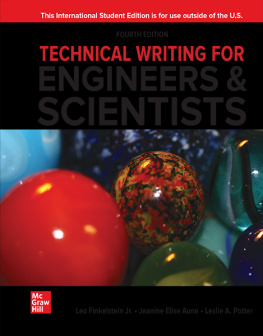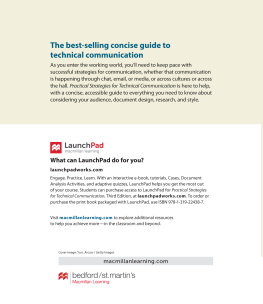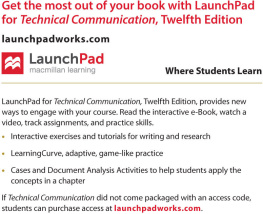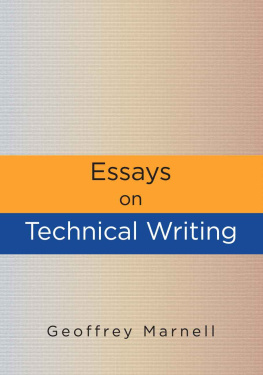Contents
Landmarks
List of Figure
List of Table
Page List
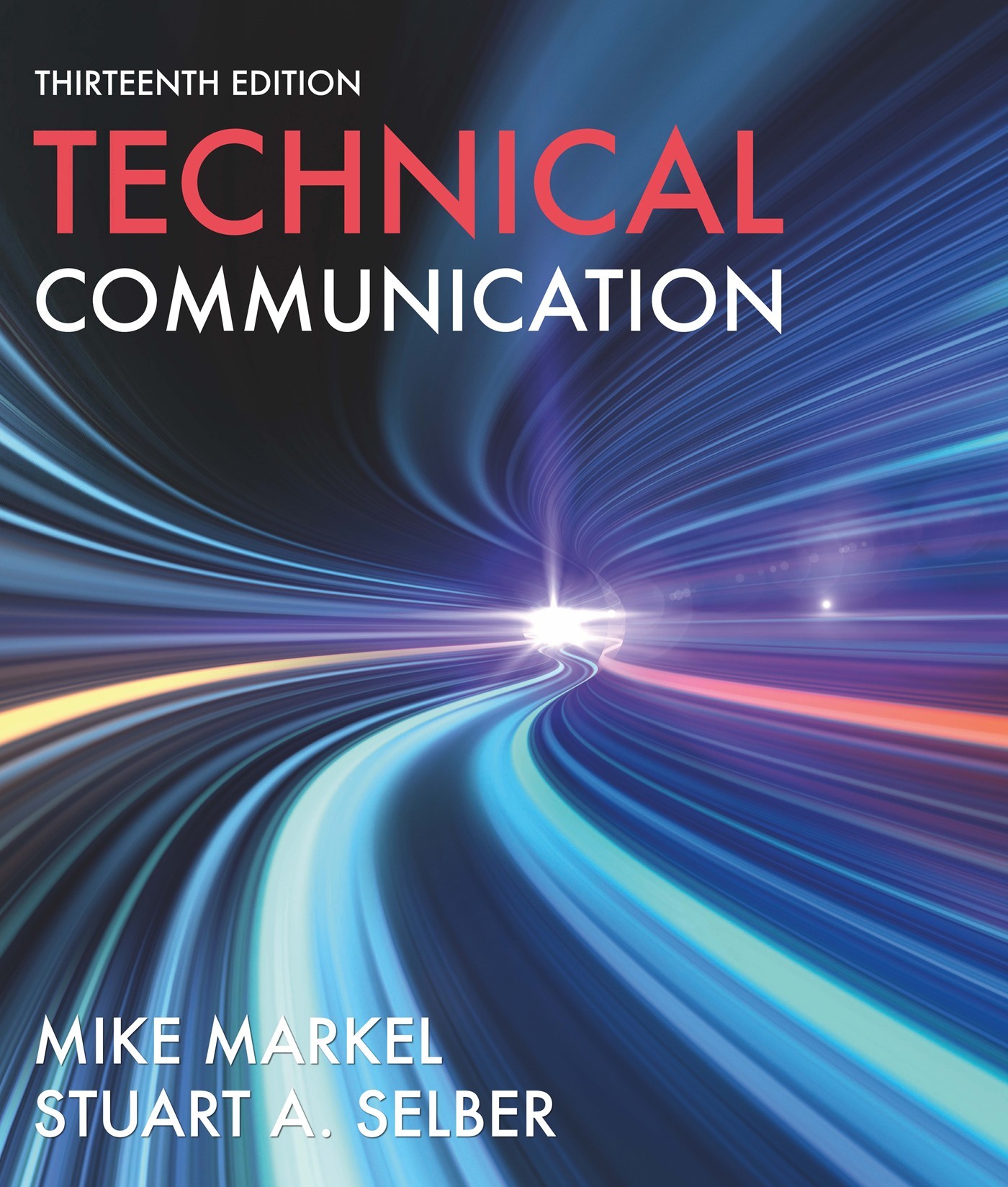
The front cover shows the name of the book, Technical Communication, at the top, followed by the text, Thirteenth Edition. On the bottom right is the authors name, Mike Markel Stuart A. Selber. The icon of Macmillan Learning is on the bottom left.

A logo of Achieve is at the top of the inside front cover. Text on the inside front cover reads as follows. Engage more. Achieve more. Achieve with Technical Communication gives students exciting new ways to engage with course material and become better writers. (Bullet) Individualized study plans personalize your learning. (Bullet) Pre-built assignments support the books approach: Writing Memos, Cover Letters, Proposal Introductions, Directives, Recommendations, Lab Reports, Instructions, and Oral Presentations. (Bullet) Draft Goals make assignment expectations clear. (Bullet) Peer review tools help you use instructor and peer feedback productively. (Bullet) Revision planning tools help you chart a concrete path to improvement. (Bullet) Reflection prompts help you transfer learning to other writing assignments. (Bullet) Source Check alerts you to potential plagiarism issues and links you to revision help. (Bullet) Easy-to-read dashboards show your assignment status, progress, and improvement. (Bullet) A built-in e-book means no more scrambling to find help. If your instructor has assigned Achieve with Technical Communication, you can easily register at achieve dot macmillan dot com. Access code required. Be the writer you want to be.
Technical COMMUNICATION
Vice President: Leasa Burton
Program Director, English: Stacey Purviance
Senior Program Manager: Laura Arcari
Director of Content Development: Jane Knetzger
Executive Manager, Development: Maura Shea
Senior Development Editor: Sherry Mooney
Assistant Editor: Annie Campbell
Director of Media Editorial: Adam Whitehurst
Media Editor: Julia Domenicucci
Executive Marketing Manager: Joy Fisher Williams
Senior Director, Content Management Enhancement: Tracey Kuehn
Senior Managing Editor: Michael Granger
Senior Manager of Publishing Services and Content Project Manager: Andrea Cava
Lead Digital Asset Archivist and Senior Workflow Project Manager: Jennifer Wetzel
Production Supervisor: Brianna Lester
Director of Design, Content Management: Diana Blume
Interior Design: Maureen McCutcheon Design
Cover Design: William Boardman
Director of Rights and Permissions: Hilary Newman
Photo Permissions Editors: Angie Boehler; Krystyna Borgen, Lumina Datamatics, Inc.
Director of Digital Production: Keri deManigold
Advanced Media Project Manager: Sarah OConnor Kepes
Project Management: Lumina Datamatics, Inc.
Project Managers: Gunjan Chandola Bhatt, Misbah Ansari/Lumina Datamatics, Inc.
Composition: Lumina Datamatics, Inc.
Cover and Title Page Image: Copyright Xinzheng. All Rights Reserved./Moment/Getty Images
Copyright 2021, 2018, 2015, 2012 by Bedford/St. Martins. All rights reserved. No part of this book may be reproduced, stored in a retrieval system, or transmitted in any form or by any means, electronic, mechanical, photocopying, recording, or otherwise, except as may be permitted by law or expressly permitted in writing by the Publisher.
ISBN 978-1-319-30769-1 (epub)
123456252423222120
Acknowledgments
Acknowledgments and copyrights appear on the same page as the text and art selections they cover; these acknowledgments and copyrights constitute an extension of the copyright page.
For information, write: Bedford/St. Martins, 75 Arlington Street, Boston, MA 02116
Preface for Instructors
TECHNICAL COMMUNICATION has, by definition, always involved technology in fundamental ways, from the tools people use to produce and access workplace documents to the subject matter of those documents and the contexts in which they are implemented. Previous editions of Technical Communication have responded to this reality by providing a variety of valuable tools for students on how to use technology in effective ways. Tech Tips, examples from a variety of media, and the inclusion of the LaunchPad platform with its suite of additional resources helped to train generations of students in how to take advantage of the affordances of technology. When considering the changes needed for the thirteenth edition, however, we acknowledged that the concerns of todays learners are less a matter of how to use a particular tool though support in that area is still a key to success and more a question of why and when to use what tools to achieve a specific rhetorical goal. Which is to say that with a vast array of technology available, we felt that it was most important for students to appreciate the context and implications of their digital choices, developing an evaluative perspective that will serve them through generations of technological evolution.
In technical-communication situations, however, that evolution is a multidimensional process with both social and technical aspects. A new feature, Strategies for Online Communication, has been added to the thirteenth edition to address this process. Professionals from a diverse array of fields provide models of their writing to showcase key digital skills they employ in their work. Annotations provided by those professionals highlight the rhetorical moves and technical considerations they made while developing the document. This new feature explores the complex factors in digital-specific situations, including how to effectively implement recurring content, how to crowd-source data and information, and how to integrate multiple modalities into a single end-product. These real-world models present technology in all its possibility and complexity and truly speak to the decisions available to todays technical communicators.
Finally, although it doesnt always feel this way, technology tends to be more evolutionary than revolutionary in nature. Although the web has enabled people to communicate in new and different ways, it involves practices and perspectives that derive from earlier media. For better or worse, the page metaphor still has a notable impact on website design and use, and techniques from film, television, and music production help inform the creation of digital content for technical communication. The new edition embraces this sort of change and continues to provide thorough guidance on traditional, still-valuable approaches to writing while making clear connections to emerging approaches. A great example of this in the thirteenth edition is our newly enhanced coverage on rsum writing in , Applying for a Job. Along with a complete explanation of the elements and variations for print-based rsums and cover letters, the new edition presents students with the fuller range of options that technology makes available, including a new visually enhanced rsum, an infographic rsum, and a video rsum. This new coverage showcases the evolution of this particular genre and equips students to make effective decisions based on their specific rhetorical needs.


